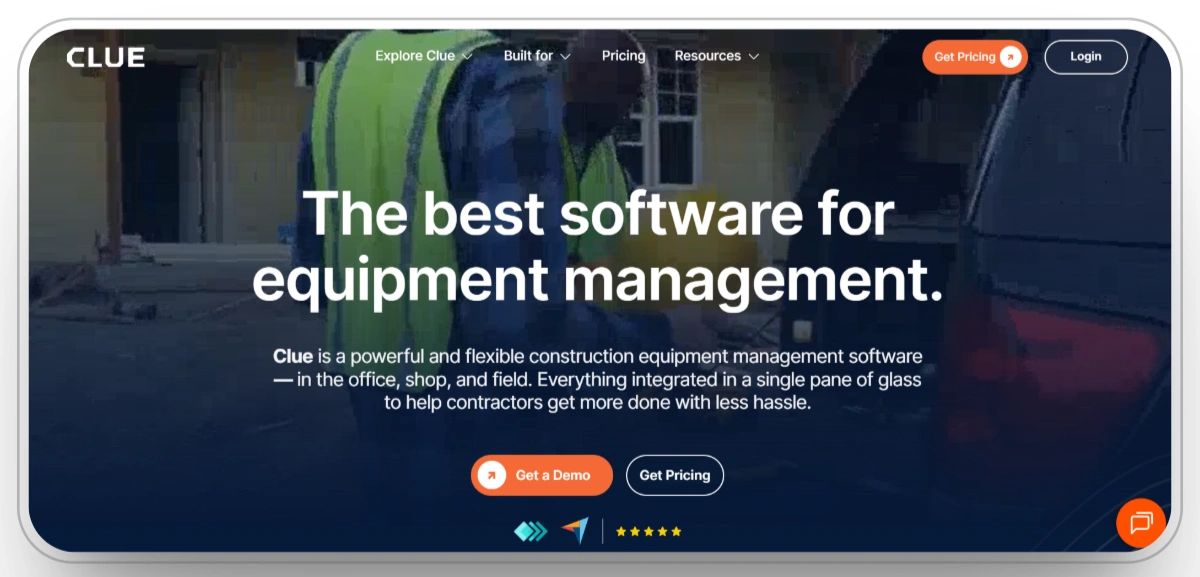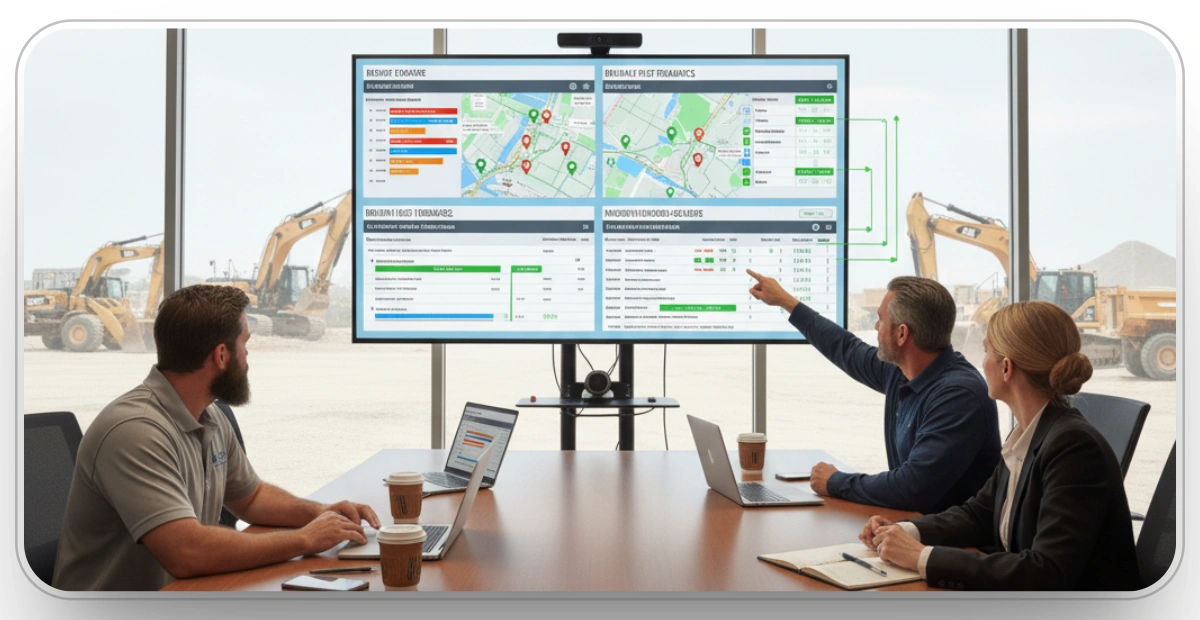Construction Dispatch Software: Common Integration Issues & Fixes
Construction fleets are increasingly relying on multiple software systems for everything from telematics and fuel tracking to maintenance and dispatch management. Yet, more than 46% of fleets report using ten or more siloed systems, which can create inefficiencies and data fragmentation.
This issue is exacerbated by a broader industry challenge: data and systems integration remains one of the top obstacles for construction firms adopting digital solutions. For fleet managers using systems, integrating dispatch software with ERP, telematics, maintenance, and accounting tools is no longer a luxury; it's essential for operational efficiency and cost control.
In this post, we’ll focus on the most common integration issues fleet managers face, what causes them, and how to resolve these challenges to optimize your fleet operations.
Key ERP System Integration Challenges
- Data Mapping and Format Mismatches: One of the biggest hurdles with dispatch software integration into ERP systems is the mismatch in data formats. For example, the dispatch software may use an equipment ID format that’s incompatible with the ERP system’s asset codes. As a result, project costs and asset utilization data fail to sync properly.
Different systems may have varying data structures or naming conventions, leading to data inconsistency between dispatch and accounting systems.
- Legacy ERP Systems Without API Support: Many construction companies still rely on legacy ERP systems, such as Viewpoint Vista or custom-built software that lacks modern API support. Without an API, it becomes challenging for dispatch software to communicate with ERP systems in real time.
Legacy systems weren’t built to integrate with modern dispatch tools, which often leads to data silos.
- Synchronization Delays: Dispatch and ERP systems often do not sync in real time, leading to data discrepancies. For example, if equipment usage is updated in the dispatch system but not reflected in the ERP until the next scheduled batch sync, job costing or billing might be based on outdated data.
Many ERP systems rely on batch processing, which delays updates and causes misalignment in critical data, like equipment availability and usage hours.
- Duplicate Data Entry: Without proper integration, dispatch data often needs to be manually re-entered into the ERP system, which wastes time and increases the risk of billing and payroll errors.
Key GPS/Telematics Integration Challenges

- Fragmented Telematics Data: Construction fleets often use a mix of telematics solutions, with some assets having proprietary GPS devices and others using aftermarket solutions..
This fragmented approach leads to siloed data, making it difficult for dispatch software to pull consistent and accurate information on equipment location, usage, and condition. Telematics systems often use proprietary platforms that do not align with dispatch software APIs.
- Inaccurate or Missing GPS Data: GPS and telematics devices can sometimes fail to capture accurate data, especially in remote locations or areas with weak signal strength.
For instance, if the GPS signal drops, the dispatch system may not get updated data on equipment location or usage. Telematics hardware may lack robust offline capabilities, causing data gaps when signal strength is low.
- Compatibility with Dispatch Software: When telematics providers update their firmware or APIs, it can break the integration with the dispatch system.
This is particularly problematic if the dispatch system is not regularly updated to support the new API versions. Disparate software versions or lack of synchronization between telematics and dispatch platforms can break data flow and result in unreliable equipment tracking.
- Vendor Management Complexity: Using different vendors for telematics hardware, software, and installation increases the complexity of troubleshooting and support.
For instance, if an issue arises with the GPS data not syncing to the dispatch system, it’s often unclear whether the issue lies with the telematics hardware, the software, or the integration itself. Using multiple, disconnected vendors creates confusion and delays when trying to resolve issues.
Key Maintenance Tracking Integration Challenges
- Undocumented Downtime: When equipment is undergoing maintenance, it’s critical for the dispatch system to reflect that status. Otherwise, there’s a risk of scheduling equipment that’s unavailable.
Maintenance teams may update the status in their internal system, but the dispatch system is not automatically updated, leading to scheduling errors.
- Disconnected Preventive Maintenance (PM) Scheduling: Dispatch software logs equipment usage data (like engine hours or miles traveled), which should trigger scheduled maintenance.
Without integration between dispatch and maintenance systems, this data may not be used to schedule preventive maintenance. This disconnect between systems can lead to missed or delayed preventive maintenance activities.
- Manual Work Order Data Entry: When maintenance work orders are completed, details such as repair costs and labor hours need to be transferred to accounting or the ERP system.
When systems aren’t integrated, details must be entered manually slowing workflows and increasing the risk of errors due to redundant data entry.
- Incompatibility Between Systems: Older or custom-built maintenance management systems may not have the capability to integrate with dispatch software, making it difficult to keep the data in sync across both platforms. This is often due to a lack of APIs or standardized data formats that support integration.
Key Accounting Integration Challenges

- Cost Code and Job Reference Mismatches: Dispatch systems may use informal job names or codes, while accounting systems require precise, standardized codes for cost allocation and billing. This can lead to inaccuracies in financial reporting. These issues often stem from a lack of standardized codes and manual data entry errors.
- Revenue Leakage from Missed Usage Logs: If equipment usage logs aren’t transferred to the accounting system in time, billable hours may be missed, resulting in lost revenue. This often happens due to manual reporting processes or delayed data synchronization between systems.
- Manual Data Entry into Financial Systems: Without full integration, accounting staff must manually re-enter usage data from dispatch systems into financial software, increasing the risk of errors and delays. Disconnected systems requiring repetitive manual data entry.
- Limited Financial Visibility: Without integrated reporting, it’s difficult to assess the true cost of asset ownership and utilization, hindering the ability to make informed decisions about fleet management. This is caused by siloed financial and operational data that aren’t connected across systems.
General Solution Strategies to Address Dispatch Integration Challenges

To overcome the challenges of integrating construction dispatch software with other systems (ERP, telematics, maintenance, accounting), fleet managers must implement strategies that streamline data flow, ensure real-time visibility, and automate workflows. Below are key strategies to optimize dispatch operations and drive better integration.
1. Unified Data & Single Source of Truth
A major hurdle in dispatch integration is data fragmentation. When fleet managers rely on multiple systems for various tasks, like tracking equipment hours or managing maintenance schedules, data often becomes disconnected, leading to confusion, manual errors, and inefficiencies. According to recent industry surveys, 76% of construction companies report data integration challenges, often affecting budgeting and project delivery.
By consolidating data into a single source of truth, all stakeholders can access the same, up-to-date information, ensuring that decisions are made with the most accurate data available.
How to Implement It
- Data Standardization: Standardize key fields (e.g., equipment IDs, project codes) across systems to ensure compatibility.
- Middleware Solutions: Use integration platforms to connect different systems into a unified data flow.
- Cloud Platforms: Adopt cloud-based platforms that centralize all dispatch, maintenance, and tracking data in one accessible dashboard.
2. Real-Time Asset Visibility & Status Updates
Real-time asset visibility is crucial for making informed dispatch decisions. Without accurate, up-to-date information on equipment availability, location, and condition, fleet managers are at risk of overbooking or assigning unavailable machines. Real-time tracking of assets can help avoid scheduling conflicts, downtime, and inefficiencies.
How to Implement It
- Telematics Integration: Integrate GPS and telematics devices with dispatch software to capture real-time location, usage, and condition data for each asset.
- Dynamic Scheduling: Implement software that updates asset availability in real-time as equipment moves between jobs or is taken out of service.
3. Seamless Workflow Integration
To avoid manual data entry and reduce errors, dispatch software should be integrated with maintenance and accounting systems. When an asset is used, that information needs to seamlessly flow to maintenance (for scheduling PMs or repairs) and accounting (for billing or cost tracking). This integration streamlines operations and ensures that all records are consistent across platforms.
How to Implement It
- API Integration: Leverage APIs to connect dispatch software with ERP, maintenance management, and accounting platforms for a smooth data flow.
- Automated Data Sync: Use integration platforms (iPaaS tools) to automate the flow of data between dispatch, maintenance, and accounting systems.
4. Scalable, Modular Integration Approach
As construction fleets grow and technology evolves, systems need to adapt without requiring an entire overhaul. Implementing a modular integration approach allows fleet managers to add new tools or scale up operations without disrupting existing workflows.
A flexible, scalable integration strategy ensures that systems evolve with the business and remain adaptable as new technologies are introduced.
How to Implement It
- Modular System Design: Choose systems that are modular and can integrate with new tools or technologies as needed.
- Open APIs: Select platforms that offer open APIs for easy connections to third-party tools and future-proof your system.
5. Data-Driven Dispatch Optimization
Effective dispatching goes beyond simply scheduling equipment. By utilizing real-time data, fleet managers can optimize routes, minimize idle time, and improve overall fleet utilization. Data-driven dispatch decisions lead to increased productivity and reduced operational costs.
How to Implement It
- Utilization Reports: Use data from telematics and dispatch systems to generate reports on equipment usage, fuel consumption, and idle time.
- AI-Driven Scheduling: Implement AI-powered scheduling tools that optimize dispatch decisions based on availability, maintenance schedules, and project needs.
These strategies establish the foundation for a connected dispatch ecosystem where every decision is driven by accurate, real-time data. The next step is implementing a solution that brings these capabilities together in one place. That’s where Clue enters, built to unify dispatch, telematics, maintenance, and accounting through seamless integration and actionable insights.
How Clue Delivers on Dispatch Integration Solutions

Clue is a unified construction fleet management platform designed to centralize dispatch, telematics, maintenance, and accounting. It aligns closely with the five key solution strategies outlined earlier, offering a connected, data-driven environment for fleet and dispatch managers.
1. Unified Data & Single Source of Truth
Clue offers a “single pane of glass” for construction operations. Our platform consolidates dispatch, asset management, utilization, maintenance, and rentals into one interface.
- Supports 70+ integrations, including leading ERP and telematics systems like Viewpoint Vista, Oracle JDE/E1, and major OEM GPS providers.
- Allows custom API integrations for bespoke workflows.
- Centralizes job codes, equipment IDs, and utilization data for consistent visibility across departments.
Fleet managers gain a unified view of asset data, no more toggling between spreadsheets or systems. Accurate, real-time information supports confident, data-driven dispatch decisions.
2. Real-Time Asset Visibility & Status Updates
Clue enables live asset tracking and provides instant equipment status updates within its dispatch dashboard.
- Displays asset location, availability, and current job status.
- Integrates with telematics hardware from virtually any vendor using open API support.
- Supports mobile access, giving field teams visibility on equipment in motion.
Real-time visibility reduces idle time, prevents double bookings, and helps dispatchers allocate resources efficiently. Clue customers have reported significant gains, including tripling daily service job completions and saving over $1 million annually after implementation.
3. Seamless Workflow Integration
Clue connects the full operational workflow from job dispatch to repair and cost tracking, by integrating with ERP and CMMS platforms. This eliminates manual data entry between systems and ensures maintenance schedules and financial records are always up to date, allowing dispatchers to focus on operations instead of admin tasks.
- Links dispatch usage data to maintenance systems for automatic preventive maintenance (PM) triggers.
- Synchronizes completed repair costs with accounting and job costing systems.
- Compatible with HCSS Equipment360, eMaint, and other major CMMS tools.
4. Scalable, Modular Integration Approach
Clue’s modular design allows construction businesses to adopt features in phases. Construction operations evolve, new equipment, job types, and technologies emerge. A modular, scalable platform ensures integrations remain sustainable without the need for constant rebuilds.
- Implement core modules (Dispatch + Asset Tracking) first, then expand to Maintenance, Fuel Tracking, or Analytics.
- Enables a fast, low-disruption implementation, with flexibility to scale as fleet size or operational complexity increases.
5. Data-Driven Dispatch Optimization
Clue turns integrated data into actionable intelligence. With centralized analytics, dispatch managers can refine scheduling, cut idle time, and improve ROI per asset, transforming dispatch from a logistical task into a profit center.
- Offers Equipment Economics dashboards that monitor spending across fuel, repairs, and rentals.
- Provides production tracking and utilization analytics to identify idle assets and improve resource allocation.
- Enables data-driven scheduling and cost analysis in real time.
Best Practices for Seamless Integration

Successfully integrating construction equipment dispatch software with ERP, telematics, maintenance, and accounting systems requires a strategic approach. Here are some best practices:
- Data Standardization: Ensure that all systems use consistent data formats, terminologies, and job codes to avoid integration issues.
- Use Open APIs: Choose software solutions that support open APIs and industry standards to facilitate seamless communication between platforms.
- Monitor and Test: Regularly test integrations and set up continuous monitoring to catch issues early.
- Involve Stakeholders: Ensure that all departments are engaged in the integration process to promote system adoption and streamline workflows.
- Plan for Scalability: Select systems that can grow with your business and adapt to new technologies.
By addressing integration challenges head-on, fleet managers can optimize their operations, improve data accuracy, and ultimately drive cost savings across their organization.
Final Thoughts
Integrating Clue into your dispatch operations is not just a software upgrade, it's a structural improvement in how your fleet communicates, operates, and scales. With its ability to unify systems, streamline data flow, and provide actionable analytics, Clue empowers fleet managers to move from reactive scheduling to proactive, data-informed decision-making.
By following a strategic rollout, starting small, ensuring strong user adoption, and scaling gradually, companies can minimize risk while unlocking measurable benefits such as reduced idle time, improved utilization, and lower operational costs.
In an industry where efficiency directly impacts profitability, Clue stands out as a platform built to bridge the gap between field operations and back-office systems. It gives construction firms a unified ecosystem where dispatch, maintenance, and accounting work together in real time no longer in silos.
If implemented thoughtfully, Clue doesn’t just solve today’s integration problems, it creates a digital foundation for tomorrow’s construction fleet.
FAQs
1. What features should a dispatch software have to manage both crews and heavy equipment?
Look for scheduling tools that handle jobs, equipment, and personnel together. The software should offer real-time visibility of locations and status, work order creation, and integration with telematics and resource data.
2. How important is integration between dispatch software and telematics or GPS tracking?
Very important. Dispatch decisions depend on knowing where equipment is and whether it’s available. Integrating telematics means your dispatch board reflects live data rather than outdated info.
3. Can dispatch software alone ensure efficient equipment utilization?
Not fully. While dispatch software allocates assets, efficient utilization also requires data on idle time, usage hours, maintenance status, and cost. Without those, you may schedule assets that aren’t ready or optimal.
4. What role does mobile access play in dispatch software for construction sites?
A critical role. Field teams are often on site or remote; mobile access lets them receive assignments, update status, capture data, and enable dispatchers to react quickly to changes.
5. How should dispatch software help reduce equipment idle time and unnecessary rentals?
By showing real‐time availability of assets, highlighting under-utilized machines, integrating maintenance status (to avoid sending broken equipment), and enabling re-assignment instead of renting. These features help reduce idle time and rental cost overhead.
Transform Your Equipment Management













